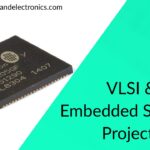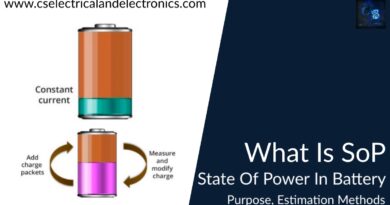What Is Primary Memory, Different Types Of Primary Memories
Hello guys, welcome back to my blog. In this article, I will discuss what is primary memory, different types of primary memories, how primary memory is different from secondary memory, etc.
If you have any doubts related to electrical, electronics, and computer science, then ask questions. You can also catch me on Instagram – Chetan Shidling.
Also, read:
CommunicationsElectronicsEmbedded System
- Different Types of Serial Communication Protocols, Serial Protocols.
- Roadmap To Become A Robotics Engineer, Skills, Jobs, Responsibilities.
- Types Of Sensors Used In Mobile Phones, Sensors Used In Android Phones.
What Is Primary Memory
A computer’s main memory may be divided into three categories. namely,
a. Main memory, which stores the current program’s instructions and data,
b. Cache memory, which improves CPU performance by storing a copy of the instructions/data stored in the main memory to avoid unnecessary retrieval, and
c. Register memory, which stores information required by the CPU’s arithmetic and logical units to execute the instructions.
What is Primary Memory?
Primary memory is a collection of memory units within a computer to which the CPU has direct access and which stores instructions and data for CPU processing. Before being placed in permanent storage, the intermediate and outcomes of the processing are stored in primary memory. Some of this memory is volatile, meaning the contents will be deleted if the power is turned off, while others are non-volatile, meaning the data will not be erased.
Different Types of Primary Memory
Below are the Types mentioned:
01. Main Memory
When compared to Cache Memory and Register Memory, Main Memory has the biggest capacity but the lowest cost. Random Access Memory (RAM) and Read-only Memory (ROM) are the two major forms of main memory, each of which is further split into subtypes.
Random Access Memory
When the power is turned off, the memory loses its contents, making it a volatile form of memory. The processor reads and puts data and instructions into it. The external hard disc is used to load data and instructions into RAM, and the processed data is saved back to the hard disc.
In random access mode, data from RAM is read directly using memory addresses, regardless of their length (16/32/64 bits). As a result, data may be retrieved from RAM at a quicker pace than from an external hard disc, and reading from RAM takes the CPU about 10 nanoseconds.
Because this memory is more expensive, most systems limit the amount to 1 GB. Because each place in RAM is uniquely identifiable by an address, the processor refers to the instructions or data stored there, and these addresses are saved in CPU registers during runtime.
RAM has two subcategories:
a. Static Random Access Memory (SRAM): This memory uses transistors and requires continual power flow to keep it alive. Because the data in this memory is static, no refresh is required at any moment. It has a quick read/write cycle, is smaller in size, costs more than dynamic RAM, and is faster in data retrieval and write, therefore it’s used in niche applications like cache memory.
b. Dynamic Random Access Memory (DRAM): Capacitors are employed in this type, and it tends to lose energy over time, which means data is likely to be lost. To keep the data, it must be refreshed regularly. It is a high-density kind that is less expensive than SRAM but slower and bigger in size and is mostly utilized in main memory.
Read-only Memory (ROM)
Non-volatile memory retains its contents even after the power is turned off. The contents of these memory regions can only be read, not deleted or overwritten, as the name implies. During the production stage, items such as the boot software, firmware, and mathematical tables in scientific applications are saved and sold with pre-stored contents.
ROM has two subcategories:
a. Programmable ROM (PROM): The difference between ROM and PROM is that ROM comes preloaded with data, whereas PROM comes with a blank memory and the data is placed in PROM using a device called a PROM programmer. During production, ROM is pre-loaded with confirmed and ready-to-use content, whereas PROM provides the flexibility and time to burn the data once the content has been verified.
b. Erasable Programmable ROM (EPROM): EPROM may be wiped and reprogrammed once it has been programmed. The electrical signal can be used to delete any previously recorded data. EEPROM is the name for this type of PROM. UV rays may also be used to wipe data, and such devices are known as UV EPROMs. The technique of deleting data using an electric signal is less complicated than utilizing UV rays.
Read the article: Types of memories
02. Cache Memory
Frequently mentioned Instructions and data are stored in a dedicated quicker memory in the CPU to save time and effort in retrieving them from the slower main memory. Cache memory is a type of storage that ranges in size from 2KB to 64KB. This memory is significantly smaller than the main memory, and it costs more than the main memory but less than the Resisters.
03. Register Memory
During program execution, registers in the CPU are used to retain the memory locations of the data, the next instruction, and interim results. It also serves as a buffer between the processor and the main memory. It is the most expensive memory and the lowest in terms of size.
To sum up, The program’s operation is heavily reliant on primary memory. Any enhancements in-memory operations will result in faster program execution and, as a result, increased business operation efficiency. Continuous improvements are being made in this area to satisfy the demands of the digital world.
I hope this article “What Is Primary Memory” may help you all a lot. Thank you for reading.
Also, read:
- 100 + Electrical Engineering Projects For Students, Engineers
- 1000+ Electronics Projects For Engineers, Diploma, MTech Students
- 1000+ MATLAB Simulink Projects For MTech, Engineering Students
- 500+ Embedded System Projects For Engineer, Diploma, MTech, PhD
- 500+ Projects For Diploma Electrical, Electronics Student, Diploma Project
- 8051 Microcontroller Timers, TCON Register, TMOD Register
- Advancements In 3D Printing Technology And It’s Future
- Advancements In Power Electronics For Energy Efficiency
Author Profile
- Content Writer
Latest entries
 All PostsAugust 25, 2021Top 16 Highest Paying Engineering Jobs in the USA For Freshers
All PostsAugust 25, 2021Top 16 Highest Paying Engineering Jobs in the USA For Freshers All PostsAugust 23, 2021Top 10 Smart Cities In The World, Best Cities To Visit In The World
All PostsAugust 23, 2021Top 10 Smart Cities In The World, Best Cities To Visit In The World All PostsAugust 21, 2021Top 20 VLSI & Embedded Systems Projects for Mtech Students
All PostsAugust 21, 2021Top 20 VLSI & Embedded Systems Projects for Mtech Students All PostsAugust 21, 2021Top 20 Power Systems Projects For MTech Students, Engineering Students
All PostsAugust 21, 2021Top 20 Power Systems Projects For MTech Students, Engineering Students








